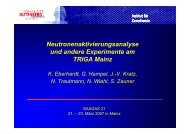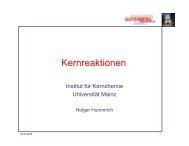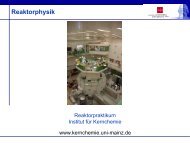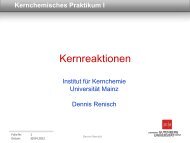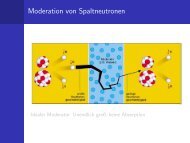jahresbericht 2007 - Institut für Kernchemie - Johannes Gutenberg ...
jahresbericht 2007 - Institut für Kernchemie - Johannes Gutenberg ...
jahresbericht 2007 - Institut für Kernchemie - Johannes Gutenberg ...
Create successful ePaper yourself
Turn your PDF publications into a flip-book with our unique Google optimized e-Paper software.
Is the brain uptake of the 5-HT 2A Ligand [ 18 F]MH.MZ affected<br />
by the P-glycoprotein ?<br />
Ulrich Schmitt, Fabian Debus, Dianne E. Lee, Katrin M. Kirschbaum, Matthias M. Herth, Marcus Piel , Hans-Georg<br />
Buchholz, Matias Schreckenberger, Frank Roesch and Christoph Hiemke<br />
<strong>Institut</strong>e of Nuclear Chemistry, <strong>Johannes</strong> <strong>Gutenberg</strong>-University Mainz, Mainz, Germany<br />
Molecular and Cellular Pharmacology, Stony Brook University, Stony Brook, New York<br />
Introduction: P-glycoprotein (P-gp) belongs to the<br />
superfamily of ATP-binding cassette transport proteins<br />
in the blood brain barrier. P-gp functions as an efflux<br />
pump limiting the access of xenobiotics into the CNS<br />
compartment. This efflux pump has been shown to<br />
oppose passive diffusion of many antipsychotic and<br />
antidepressant drugs (Doran et al., 2005). The transport<br />
activity of P-gp can be blocked by a substrate, such as<br />
cyclosporine A, enhancing accumulation of the<br />
therapeutic drug in the brain, due to competitive<br />
inhibition between both substrates for the efflux<br />
transporter. MDL 100907, a derivative of MH.MZ, is a<br />
potent 5HT 2A receptor antagonist (Ki = 0.68-1.4 nM)<br />
shown to be an effective drug to treat schizophrenia<br />
(Sorensen et al., 1993). Many studies have evaluated<br />
[ 11 C]MDL 100907 as a valid PET imaging agent.<br />
Recently, we developed an 18 F-labeled version as a<br />
PET radioligand. Because another 5HT 2A antagonist,<br />
18 F-Altanserin similar in structure, is a substrate for P-<br />
gp 1 we tested [ 18 F]MH.MZ in P-gp KO and wild type<br />
mice to assess its vulnerability to P-gp transport in both<br />
brain and plasma.<br />
Experimental: Male mdr1a/1b double-knockout mice<br />
and male WT controls (20 - 28 g) were used. The<br />
radiotracer [ 18 F]MH.MZ was synthesized and applied<br />
IP (~ 12 MBq) to P-gp KO (n=3) and wildtype (n=4)<br />
mice. Following a 45 min awake uptake period, mice<br />
were anaesthetised with chloral hydrate (7%) by i.p.<br />
injection of 6 mL/kg. and a 10 min static scan ensued.<br />
Images were reconstructed by a 3D maximum a<br />
posteriori (MAP) algorithm. Tomographic images were<br />
analyzed with pixel-wise modeling computer software<br />
(PMOD; Zurich, Switzerland). Region of interest<br />
(ROI) template was applied and included 5 regions;<br />
frontal cortex, thalamus, hippocampus, hypothalamus<br />
and cerebellum. Data was normalized for whole brain<br />
uptake and compared between groups (P-gp KO vs.<br />
wild type) using P < 0.05 significance threshold.<br />
Results: We observed a global increase of<br />
[ 18 F]MH.MZ uptake qualitatively in P-gp KO vs. wild<br />
type mice (Fig. 1). ROI results (Fig. 2) show the<br />
greatest change in the frontal cortex (~20% increase)<br />
and hypothalamus (~25% decrease). Further,<br />
statistically significant increases occurred in the<br />
.<br />
thalamus (~ 15 %) and hippocampus (~15 %);<br />
however, no significant change was observed in the<br />
cerebellum.<br />
Wild type mouse mdr1a(+/+)/1b(+/+)<br />
rostral<br />
KO mouse mdr1a(-/-)/1b(-/-)<br />
caudal<br />
Fig.1: Mean normalized PET images. An enhancement of<br />
[ 18 F]MH.MZ uptake is clearly visible in P-gp deficient mice<br />
Conclusion: Our in vivo data revealed a increase in<br />
uptake of the radiolabeled tracer in P-gp KO compared<br />
to wild type animals, specifically in regions of the<br />
brain that would have had limited access to the ligand<br />
due to its binding properties to the efflux transporter.<br />
The uptake profile was in agreement with regions of<br />
the brain known to have the riches 5HT 2A receptors<br />
with the highest relative change in the frontal cortex (~<br />
20 %) and no change in the cerebellum devoid of<br />
5HT 2A .<br />
References<br />
[1] Palner et al. (<strong>2007</strong>); The effects of a P-<br />
Glycoprotein inhibitor on rat brain uptake and binding<br />
of [ 18 F]Altanserin: A microPET study, Journal of<br />
Cerebral Blood Flow and Metabolism, 27 (SUPPL. 1),<br />
pp. PO05-05U<br />
- B30 -



